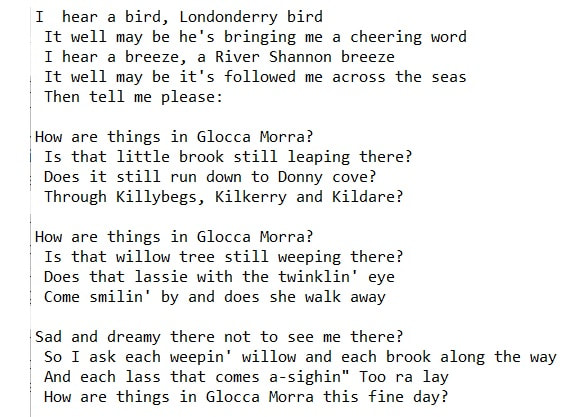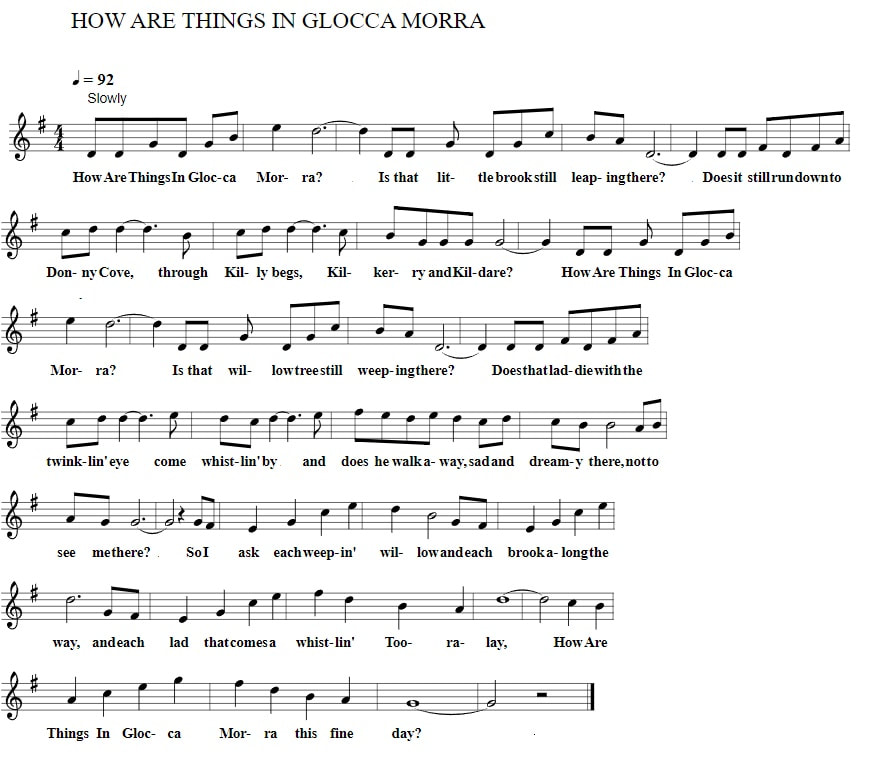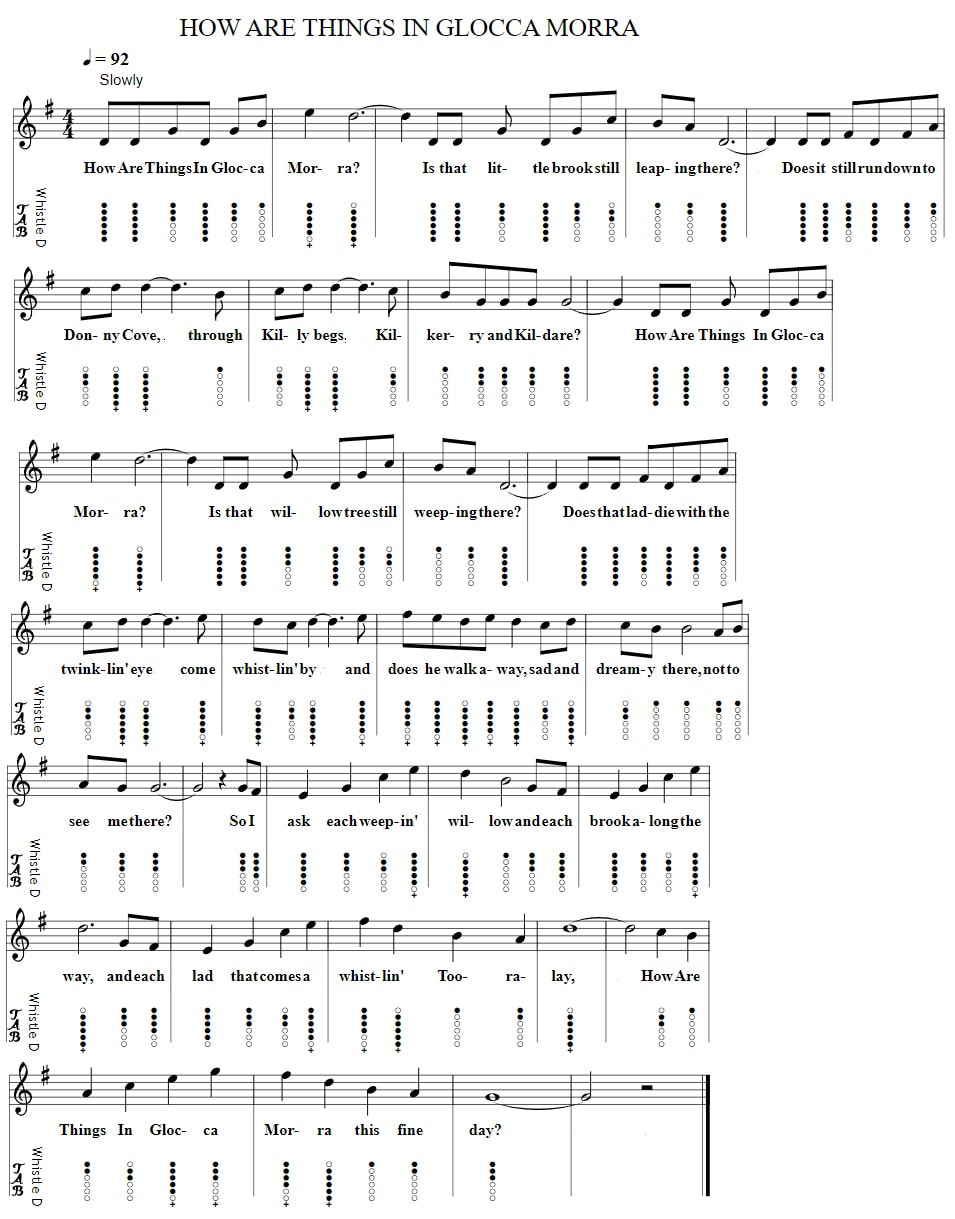How Are Things In Glocca Morra Guitar Chords And Lyrics
Recorded By Bing Crosby. Words by E.Y. Harburg, music by Burton Lane and written around 1946. The guitar chords in chordpro are in the keys of D and G.
Bing Crosbie's other songs about Ireland include Galway Bay Song . It seems like Bing was very fond of the old Irish ballads. How are things in Glocca Morra tin whistle NOTES AND PIANO SHEET MUSIC INCLUDED.
Bing Crosbie's other songs about Ireland include Galway Bay Song . It seems like Bing was very fond of the old Irish ballads. How are things in Glocca Morra tin whistle NOTES AND PIANO SHEET MUSIC INCLUDED.
Introduction
'How Are Things In Glocca Morra' is a classic song from the 1947 Broadway musical 'Finian's Rainbow' written by Burton Lane (music) and E.Y. Harburg (lyrics). The song has been covered by numerous artists and has become a popular standard in the American songbook. It is a dreamy and whimsical tune that has captivated audiences for decades with its romanticized portrayal of a fictional Irish village. The lyrics and melody of the song have a timeless quality that continues to resonate with listeners today.
In this thesis, we will explore the meaning and significance of 'How Are Things In Glocca Morra' in the context of both the musical and the socio-political landscape of the 1940s. We will examine the origins of the song, its cultural impact, and the ways in which it has been interpreted and performed over the years. Through this analysis, we will gain a deeper understanding of the song's enduring appeal and its continued relevance in contemporary society.
Historical Context
To fully appreciate the significance of 'How Are Things In Glocca Morra,' it is essential to understand the historical context in which it was created. The song was written and composed during the post-World War II era, a time of great social and political change in the United States. The country was recovering from the economic devastation of the Great Depression and the horrors of the war, and there was a renewed sense of hope and optimism for the future.
Against this backdrop, the musical 'Finian's Rainbow' was born. The show, which opened on Broadway in 1947, was a whimsical and fantastical tale about an Irish immigrant and his daughter who come to America with a pot of gold stolen from a leprechaun. The story was a commentary on the American dream and the pursuit of wealth and happiness in a land of opportunity. 'How Are Things In Glocca Morra' was a pivotal song in the show, encapsulating the themes of longing, nostalgia, and the search for a better life.
Lyrics and Melody
The lyrics of 'How Are Things In Glocca Morra' are a masterpiece of poetic imagery and wordplay. The song opens with the line 'I hear a bird, a Londonderry bird,' which immediately transports the listener to the idyllic Irish countryside. The use of onomatopoeia, such as 'lilt' and 'croon,' adds to the dreamy and musical quality of the lyrics.
The chorus of the song, 'How are things in Glocca Morra?/Is that little brook still leaping there?/Does it still run down to Donny cove?/Through Killybegs, Kilkerry, and Kildare?' is a nostalgic and wistful reflection on a simpler way of life. The repetition of the phrase 'how are things' emphasizes the longing for a place that is far away and seemingly untouched by the problems of the modern world.
The melody of the song is equally enchanting, with its lilting and flowing rhythm. The use of Irish folk music elements, such as the Irish harp and flute, adds to the authenticity and charm of the song. The melody perfectly complements the lyrics, creating a sense of longing and nostalgia that lingers long after the song has ended.
Cultural Impact
'How Are Things In Glocca Morra' was an instant hit when it was first introduced in 'Finian's Rainbow.' The show ran for 725 performances and was later adapted into a film in 1968. The song quickly became a popular standard and has been covered by many famous artists, including Bing Crosby, Ella Fitzgerald, and Judy Garland.
The song's cultural impact extends beyond the world of music and theatre. Its themes of longing and nostalgia have resonated with audiences from all walks of life, making it a timeless and universal anthem. The song has been used in various films and TV shows, such as 'The Simpsons' and 'Family Guy,' and has been referenced in literature and popular culture.
Interpretations and Performances
Over the years, 'How Are Things In Glocca Morra' has been interpreted and performed in various ways, each bringing a unique perspective to the song. In the original Broadway production, the song was sung by the character Sharon McLonergan, who longs for a simpler life in Ireland. In later productions, the song has been sung by male characters, adding a new layer of meaning to the lyrics.
The song has also been performed by artists from different genres, such as jazz, pop, and country. Each interpretation brings a different musical style and interpretation to the song, showcasing its versatility and enduring appeal.
Conclusion
In conclusion, 'How Are Things In Glocca Morra' is a timeless and beloved song that has captured the hearts of audiences for over seven decades. Its dreamy and whimsical lyrics, combined with a nostalgic melody, have made it a classic in the American songbook. The song's cultural impact and continued relevance in contemporary society are a testament to its enduring appeal and the universal themes it represents. As long as there is a longing for a simpler and happier life, 'How Are Things In Glocca Morra' will continue to be a beloved and cherished song.
'How Are Things In Glocca Morra' is a classic song from the 1947 Broadway musical 'Finian's Rainbow' written by Burton Lane (music) and E.Y. Harburg (lyrics). The song has been covered by numerous artists and has become a popular standard in the American songbook. It is a dreamy and whimsical tune that has captivated audiences for decades with its romanticized portrayal of a fictional Irish village. The lyrics and melody of the song have a timeless quality that continues to resonate with listeners today.
In this thesis, we will explore the meaning and significance of 'How Are Things In Glocca Morra' in the context of both the musical and the socio-political landscape of the 1940s. We will examine the origins of the song, its cultural impact, and the ways in which it has been interpreted and performed over the years. Through this analysis, we will gain a deeper understanding of the song's enduring appeal and its continued relevance in contemporary society.
Historical Context
To fully appreciate the significance of 'How Are Things In Glocca Morra,' it is essential to understand the historical context in which it was created. The song was written and composed during the post-World War II era, a time of great social and political change in the United States. The country was recovering from the economic devastation of the Great Depression and the horrors of the war, and there was a renewed sense of hope and optimism for the future.
Against this backdrop, the musical 'Finian's Rainbow' was born. The show, which opened on Broadway in 1947, was a whimsical and fantastical tale about an Irish immigrant and his daughter who come to America with a pot of gold stolen from a leprechaun. The story was a commentary on the American dream and the pursuit of wealth and happiness in a land of opportunity. 'How Are Things In Glocca Morra' was a pivotal song in the show, encapsulating the themes of longing, nostalgia, and the search for a better life.
Lyrics and Melody
The lyrics of 'How Are Things In Glocca Morra' are a masterpiece of poetic imagery and wordplay. The song opens with the line 'I hear a bird, a Londonderry bird,' which immediately transports the listener to the idyllic Irish countryside. The use of onomatopoeia, such as 'lilt' and 'croon,' adds to the dreamy and musical quality of the lyrics.
The chorus of the song, 'How are things in Glocca Morra?/Is that little brook still leaping there?/Does it still run down to Donny cove?/Through Killybegs, Kilkerry, and Kildare?' is a nostalgic and wistful reflection on a simpler way of life. The repetition of the phrase 'how are things' emphasizes the longing for a place that is far away and seemingly untouched by the problems of the modern world.
The melody of the song is equally enchanting, with its lilting and flowing rhythm. The use of Irish folk music elements, such as the Irish harp and flute, adds to the authenticity and charm of the song. The melody perfectly complements the lyrics, creating a sense of longing and nostalgia that lingers long after the song has ended.
Cultural Impact
'How Are Things In Glocca Morra' was an instant hit when it was first introduced in 'Finian's Rainbow.' The show ran for 725 performances and was later adapted into a film in 1968. The song quickly became a popular standard and has been covered by many famous artists, including Bing Crosby, Ella Fitzgerald, and Judy Garland.
The song's cultural impact extends beyond the world of music and theatre. Its themes of longing and nostalgia have resonated with audiences from all walks of life, making it a timeless and universal anthem. The song has been used in various films and TV shows, such as 'The Simpsons' and 'Family Guy,' and has been referenced in literature and popular culture.
Interpretations and Performances
Over the years, 'How Are Things In Glocca Morra' has been interpreted and performed in various ways, each bringing a unique perspective to the song. In the original Broadway production, the song was sung by the character Sharon McLonergan, who longs for a simpler life in Ireland. In later productions, the song has been sung by male characters, adding a new layer of meaning to the lyrics.
The song has also been performed by artists from different genres, such as jazz, pop, and country. Each interpretation brings a different musical style and interpretation to the song, showcasing its versatility and enduring appeal.
Conclusion
In conclusion, 'How Are Things In Glocca Morra' is a timeless and beloved song that has captured the hearts of audiences for over seven decades. Its dreamy and whimsical lyrics, combined with a nostalgic melody, have made it a classic in the American songbook. The song's cultural impact and continued relevance in contemporary society are a testament to its enduring appeal and the universal themes it represents. As long as there is a longing for a simpler and happier life, 'How Are Things In Glocca Morra' will continue to be a beloved and cherished song.
[D]I [G]hear a [D]bird, London[G]derry [D]bird
It [G]well may [D]be he's [G]bringing [D]me a [A]cheering [D]word
I [G]hear a [D]breeze, a River [G]Shannon [D]breeze
It [G]well may [D]be it's [G]followed [D]me a[A]cross the [D]seas
Then [A]tell me [D]please:
[A]How are [D]things in Glocca [G]Morr[D]a?
[D]Is that little brook still [A]leaping there?
Does it still run down to [Em]Donny cove?
Through Killybegs, Kilkerry and Kil[D]dare?
[A]How are [D]things in Glocca [G]Morr[D]a?
[D]Is that willow tree still [A]weeping there?
Does that lassie with the [Em]twinklin' eye
Come smilin' by and [G]does she walk away
Sad and [D]dreamy there not [A]to see [D]me there?
[D]So I [G]ask each weepin' willow and each [D]brook along the way
And each [G]lass that comes a-sighin" [A]Too ra lay
How are things in Glocca Morra this fine [D]day?
It [G]well may [D]be he's [G]bringing [D]me a [A]cheering [D]word
I [G]hear a [D]breeze, a River [G]Shannon [D]breeze
It [G]well may [D]be it's [G]followed [D]me a[A]cross the [D]seas
Then [A]tell me [D]please:
[A]How are [D]things in Glocca [G]Morr[D]a?
[D]Is that little brook still [A]leaping there?
Does it still run down to [Em]Donny cove?
Through Killybegs, Kilkerry and Kil[D]dare?
[A]How are [D]things in Glocca [G]Morr[D]a?
[D]Is that willow tree still [A]weeping there?
Does that lassie with the [Em]twinklin' eye
Come smilin' by and [G]does she walk away
Sad and [D]dreamy there not [A]to see [D]me there?
[D]So I [G]ask each weepin' willow and each [D]brook along the way
And each [G]lass that comes a-sighin" [A]Too ra lay
How are things in Glocca Morra this fine [D]day?
How Are Things In Glocca Morra Guitar Chords Key Of G Major
[G]I [C]hear a [G]bird, London[C]derry [G]bird
It [C]well may [G]be he's [C]bringing [G]me a [D]cheering [G]word
I [C]hear a [G]breeze, a River [C]Shannon [G]breeze
It [C]well may [G]be it's [C]followed [G]me a[D]cross the [G]seas
Then [D]tell me [G]please:
[D]How are [G]things in Glocca [C]Morr[G]a?
[G]Is that little brook still [D]leaping there?
Does it still run down to [Am]Donny cove?
Through Killybegs, Kilkerry and Kil[G]dare?
[D]How are [G]things in Glocca [C]Morr[G]a?
[G]Is that willow tree still [D]weeping there?
Does that lassie with the [Am]twinklin' eye
Come smilin' by and [C]does she walk away
Sad and [G]dreamy there not [D]to see [G]me there?
[G]So I [C]ask each weepin' willow and each [G]brook along the way
And each [C]lass that comes a-sighin" [D]Too ra lay
How are things in Glocca Morra this fine [G]day?
Irish songs G-J
[G]I [C]hear a [G]bird, London[C]derry [G]bird
It [C]well may [G]be he's [C]bringing [G]me a [D]cheering [G]word
I [C]hear a [G]breeze, a River [C]Shannon [G]breeze
It [C]well may [G]be it's [C]followed [G]me a[D]cross the [G]seas
Then [D]tell me [G]please:
[D]How are [G]things in Glocca [C]Morr[G]a?
[G]Is that little brook still [D]leaping there?
Does it still run down to [Am]Donny cove?
Through Killybegs, Kilkerry and Kil[G]dare?
[D]How are [G]things in Glocca [C]Morr[G]a?
[G]Is that willow tree still [D]weeping there?
Does that lassie with the [Am]twinklin' eye
Come smilin' by and [C]does she walk away
Sad and [G]dreamy there not [D]to see [G]me there?
[G]So I [C]ask each weepin' willow and each [G]brook along the way
And each [C]lass that comes a-sighin" [D]Too ra lay
How are things in Glocca Morra this fine [G]day?
Irish songs G-J



